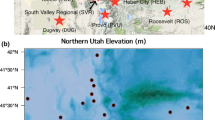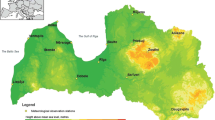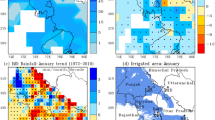Abstract
The increase in fog frequency over the past few decades is a major cause of concern for the aviation and transportation sectors. Accurate forecasting of the spatio-temporal extent of fog is crucial for minimizing socioeconomic losses. The present study attempts to characterize the fog frequency and associated meteorological factors over Kempegowda International Airport, Bengaluru (KIAB), in Karnataka, India. Maximum fog occurrence is observed during the month of December, followed by January. The time of onset of fog lies usually between 1800 and 0300 UTC. No fog is formed between 0400 and 1700 UTC indicating the role of radiation fog. The predominant wind direction during fog events is east or southeasterly. There is significant positive correlation between the fog frequency and both the northeast monsoon, October–November (0.72), as well as December–January–February (DJF) rainfall (0.80). Soil moisture conditions during the DJF period also play a key role in fog occurrence and its climatology, which is evident from the correlation coefficient of order 0.68. These suggest that further research is needed for understanding the extent of impact on aviation at KIAB.





Similar content being viewed by others
References
Ahmed, R., Dey, S., & Mohan, M. (2014). A study to improve night time fog detection in the Indo-Gangetic Basin using satellite data and to investigate the connection to aerosols. Meteorological Applications. https://doi.org/10.1002/met.1468.
Badarinath, K. V. S., Kharol, S. K., Sharma, A. R., & Roy, P. S. (2009). Fog over Indo-Gangetic Plains—a study using multisatellite data and ground observations. IEEE Journal of Selected Topics in Applied Earth Observations and Remote Sensing, 2(3), 185–1995.
Bergot, T., & Guedalia, D. (1994). Numerical forecasting of radiation fog. Part I: Numerical model and sensitivity tests. Monthly Weather Review, 122(6), 1218–1230.
Bhowmik, S. K. R., Sud, A. M., & Singh, C. (2004). Forecasting fog over Delhi—an objective method. Mausam, 55(2), 313–322.
Bhuvan-OCM2/NDVI/NRC, NRSC/ISRO-India. (2018). http://bhuvan.nrsc.gov.in/data/download/index.php?c=t&s=LV&p=ndvi. Accessed 8 Apr 2018.
Bhuvan-Thematic Services. (2018). LULC-50 K map/NRC, NRSC/ISRO-India. http://bhuvan.nrsc.gov.in/gis/thematic/index.php. Accessed 8 Apr 2018.
Bisht, D., Tiwari, S., Dumka, U., Srivastava, A., Safai, P., Ghude, S., et al. (2016). Tethered balloon-born and ground-based measurements of black carbon and particulate profiles within the lower troposphere during the foggy period in Delhi, India. The Science of the Total Environment, 573, 894–905.
Census of India. (2011). Urban Agglomerations/Cities having population 1 lakh and above” (PDF). http://www.censusindia.gov.in/2011. Accessed 20 Sept 2017.
Choudhury, S., Rajpal, H., Saraf, A., & Panda, S. (2007). Technical note: Mapping and forecasting of North Indian winter fog: An application of spatial technologies. International Journal of Remote Sensing. https://doi.org/10.1080/01431160600993470.
Cuxart, J., & Jiménez, M. A. (2012). Deep radiation fog in a wide closed valley: Study by numerical modeling and remote sensing. Pure and Applied Geophysics, 169(5–6), 911–926.
Dee, D. P., Uppala, S. M., Simmons, A. J., Berrisford, P., Poli, P., Kobayashi, S., et al. (2011). The ERA-Interim reanalysis: Configuration and performance of the data assimilation system. Quarterly Journal of the Royal Meteorological Society, 137, 553–597.
Dimri, A. P., Niyogi, D., Barros, A. P., Ridley, J., Mohanty, U. C., Yasunari, T., et al. (2015). Western Disturbances: A review. Reviews of Geophysics. https://doi.org/10.1002/2014rg000460.
Duynkerke, P. G. (1991). Radiation fog: A comparison of model simulation with detailed observations. Monthly Weather Review, 119, 324–341.
Fosu, B. O., Wang, S. Y. S., Wang, S. H., Gillies, R. R., & Zhao, L. (2017). Greenhouse gases stabilizing winter atmosphere in the Indo-Gangetic plains may increase aerosol loading. Atmospheric Science Letters. https://doi.org/10.1002/asl.739.
Gautam, R. (2014). Challenges in early warning of the persistent and widespread winter fog over the Indo-Gangetic plains: A satellite perspective. Reducing disaster: Early warning systems for climate change (pp. 51–61). Berlin: Springer.
Ghude, S. D., Bhat, G. S., Prabhakaran, T., Jenamani, R. K., Chate, D. M., Safai, P. D., et al. (2017). Winter fog experiment over the Indo-Gangetic plains of India. Current Science, 112(4), 767–784.
Goswami, P., & Tyagi, A. (2007). Advance forecasting of onset, duration and hourly fog intensity over Delhi. Research Report No. RR CM 0714, CSIR Centre for Mathematical Modelling and Computer Simulation, Bangalore, India. http://citeseerx.ist.psu.edu/viewdoc/download?doi=10.1.1.599.2641&rep=rep1&type=pdf. Accessed 26 Sept 2017.
Gultepe, I. B., Hansen, S. G., Cober, G., Pearson, J. A., Milbrandt, S., Platnick, P., et al. (2009). The fog remote sensing and modeling field project. Bulletin of American Meteorological Society, 90, 341–359.
Gultepe, I., & Heymsfield, A. J. (2016). Ice fog, ice clouds, and remote sensing; introduction. Pure and Applied Geophysics, 173, N.9. https://doi.org/10.1007/s00024-016-1380-2.2977-2982.
Gultepe, I., Heymsfield, A. J., Gallagher, M., Ickes, L., & Baumgardner, D. (2017). Ice fog: The current state of knowledge and future challenges. Meteorological Monographs, 58, 4.1–4.24.
Gultepe, I., Kuhn, T., Pavolonis, M., Calvert, C., Gurka, J., Isaac, G. A., et al. (2014). Ice fog in Arctic during FRAM-IF project: Aviation and nowcasting applications. Bulletin of American Meteorological Society., 95, 211–226.
Gultepe, I., Minnis, P., Milbrandt, J., Cober, S. G., Nguyen, L., Flynn, C., et al. (2008). The fog remote sensing and modeling (FRAM) field project: Visibility analysis and remote sensing of fog. Remote Sensing Applications for Aviation Weather Hazard Detection and Decision Support, 7088(12), 708–803.
Gultepe, I., Tardif, R., Michaelides, S., et al. (2007). Fog research: A review of past achievements and future perspectives. Pure and Applied Geophysics, 164, 1121–1159.
Hall, G. (2015). Pearson’s correlation coefficient. http://www.hep.ph.ic.ac.uk/~hallg/UG_2015/Pearsons.pdf. Accessed 7 Apr 2018.
Hosalikar, K. S., Mohan, K. N., Vashishta, R. D., & Tyagi, A. (2012). An integrated automatic aviation meteorological instrument system at CSI Airport, Mumbai. Mausam, 63(2), 247–260.
India Meteorological Department. (1982). Weather codes. Pune: IMD.
India Meteorological Department. (2008). Forecaster’s Guide, IMD, Pune. http://imdpune.gov.in/Weather/Reports/forecaster_guide.pdf. Accessed 7 Apr 2018.
Jenamani, R. (2007). Alarming rise in fog and pollution causing a fall in maximum temperature over Delhi. Current Science, 93(3), 314–322.
Karnataka Gazette. (1990). Government of Karnataka http://gazetteer.kar.nic.in/gazetteer/distGazetteer.html. Accessed 25 Sept 2017.
Krishna Moorthy, K., Babu, S. S., Badarinath, K. V., Sunilkumar, S. V., Kiranchand, T. R., & Ahmed, Y. N. (2007). Latitudinal distribution of aerosol black carbon and its mass fraction to composite aerosols over peninsular India during winter season. Geophysical Research Letters, 34(8), Article ID L08802.
Laskar, S. (2013). Some statistical characteristics of occurrence of fog over Patna airport. Mausam, 64, 345–350.
Li, Z. H., Yang, J., Shi, C. E., & Pu, M. J. (2012). Urbanization effects on fog in China: Field research and modeling. Pure and Applied Geophysics, 169(5–6), 927–939.
Liu, D., Yang, J., Niu, S., & Li, Z. (2011). On the evolution and structure of a radiation fog event in Nanjing. Advances in Atmospheric Sciences, 28(1), 223–237.
Madan, O. P., Ravi, N., & Mohanty, U. C. (2000). A method for forecasting of visibility at Hindon. Mausam, 51(1), 47–56.
Meyer, W., & Rao, G. (1999). Pure and Applied Geophysics. https://doi.org/10.1007/s000240050254.
Mohapatra, M., & Thulsidas, A. (1998). Analysis and forecasting of fog over Bangalore airport. Mausam, 49(1), 135–142.
Niu, F., Li, Z., Li, C., Lee, K. H., & Wang, M. (2010). Increase of wintertime fog in China: Potential impacts of weakening of the Eastern Asian monsoon circulation and increasing aerosol loading. Journal of Geophysical Resources. https://doi.org/10.1029/2009JD013484.
Pasricha, P. K., Gera, B. S., Shastri, S., Maini, H. K., John, T., Ghosh, A. B., et al. (2003). Role of the water vapour greenhouse effect in the forecasting of fog occurrence. Boundary Layer Meteorology, 107(2), 469–482.
Payra, S., & Mohan, M. (2014). Multirule based diagnostic approach for the fog predictions using WRF modelling tool. Advances in Meteorology. https://doi.org/10.1155/2014/456065.
Roach, W. T. (1995). Back to basics: Fog: Part 2—the formation and dissipation of land fog. Weather, 50, 7–11.
Román-Cascón, C., Steeneveld, G. J., Yagüe, C., Sastre, M., Arrillaga, J. A., & Maqueda, G. (2016). Forecasting radiation fog at climatologically contrasting sites: Evaluation of statistical methods and WRF. Quarterly Journal of the Royal Meteorological Society, 142(695), 1048–1063.
Sathiyamoorthy, V., Arya, R., & Kishtawal, C. (2015). Radiative characteristics of fog over the Indo-Gangetic Plains during northern winter. Climate Dynamics. https://doi.org/10.1007/s00382-015-2933-2.
Saurabh, K., & Dimri, A. P. (2015). Non-linearity explanation in artificial neural network application with a case study of fog forecast over Delhi region. Pure and Applied Geophysics. https://doi.org/10.1007/s00024-015-1205-8.
Sawaisarje, G., Khare, P., Shirke, S., Deepakumar, S., & Narkhede, N. M. (2014). Study of winter fog over Indian subcontinent: Climatological perspectives. Mausam, 65, 19–28.
Singh, C. (2011). Unusual long and short spell of fog conditions over Delhi and northern plains of India during December–January 2009–2010. Mausam, 62(1), 41–50.
Sreekanth, V. (2013). Satellite derived aerosol optical depth climatology over Bangalore, India. Advances in Space Research, 51(12), 2297–2308.
Srivastava, S. K., Sharma, A. R., & Sachdeva, K. (2016). A ground observation based climatology of winter fog: Study over the Indo-Gangetic Plains, India. International Journal of Environmental Chemical Ecological Geological and Geophysical Engineering, 10(7), 705–716.
Sudhira, H. S., Ramachandra, T. V., & Subrahmanya, M. H. B. (2007). City profile Bangalore. Cities, 24, 379–390.
Suresh, R., Janakiramayya, M. V., & Sukumar, E. R. (2007). An account of fog over Chennai. Mausam, 58, 501–512.
Syed, F., Körnich, H., & Tjernström, M. (2012). On the fog variability over South Asia. Climate Dynamics. https://doi.org/10.1007/s00382-012-1414-0.
Tardif, R., & Rasmussen, R. M. (2007). Event-based climatology and typology of fog in the New York City region. Journal of Applied Meteorology and Climatology, 46(8), 1141–1168.
The Hindu. (2015). Fog hits flight operations in Bengaluru, Published November 28, 2015. http://www.thehindu.com/news/cities/bangalore/fog-hits-flight-operations-at-kempegowda-international-airport-in-bengaluru/article7927436.ece. Accessed Nov 28 2017.
Times News Network. (2016). Fog disrupts 127 flights at Kempegowda International Airport, Published December 30, 2016. https://timesofindia.indiatimes.com/city/bengaluru/Fog-disrupts-127-flights-at-KIA/articleshow/56244624.cms. Accessed Nov 28 2017.
Times News Network. (2017). Fog grounds 89 flights at Kempegowda International Airport; none cancelled, Published January 2, 2017. https://timesofindia.indiatimes.com/city/bengaluru/fog-grounds-89-flights-at-kempegowda-international-airport-none-cancelled/articleshow/56284573.cms. Accessed Nov 28 2017.
Whiffen, B., Delannoy, P., & Siok, S. (2004). Fog: Impact on road transportation and mitigation options. National Highway Visibility Conference, Madison, Wisconsin, 18–19 May 2004.
Willet, H. C. (1928). Fog and haze, their causes, distribution, and forecasting. Monthly Weather Review, 56, 435–468.
Williams, A. P., Schwartz, R. E., Iacobellis, S., Seager, R., Cook, B. I., Still, C. J., et al. (2015). Urbanization causes increased cloud base height and decreased fog in coastal Southern California. Geophysical Research Letters, 42(5), 1527–1536.
Witiw, M. R., & LaDochy, S. (2008). Trends in fog frequencies in the Los Angeles Basin. Atmospheric Research, 87(3–4), 293–300.
World Meteorological Organization (WMO). (1992). International Meteorological Vocabulary (2nd ed.). Geneva: WMO. (ISBN 978-92-630-2182-3).
Zhao, S., Li, J., & Sun, C. (2016). Decadal variability in the occurrence of wintertime haze in central eastern China tied to the Pacific Decadal Oscillation. Scientific Reports. https://doi.org/10.1038/srep27424.
Acknowledgements
The first author wishes to acknowledge the University Grants Commission funding for Junior Research Fellowship and Jawaharlal Nehru University for providing the requisite facilities and assistance as part of the UPOE scheme.
Author information
Authors and Affiliations
Corresponding author
Electronic supplementary material
Below is the link to the electronic supplementary material.
Rights and permissions
About this article
Cite this article
Kutty, S.G., Agnihotri, G., Dimri, A.P. et al. Fog Occurrence and Associated Meteorological Factors Over Kempegowda International Airport, India. Pure Appl. Geophys. 176, 2179–2190 (2019). https://doi.org/10.1007/s00024-018-1882-1
Received:
Revised:
Accepted:
Published:
Issue Date:
DOI: https://doi.org/10.1007/s00024-018-1882-1




